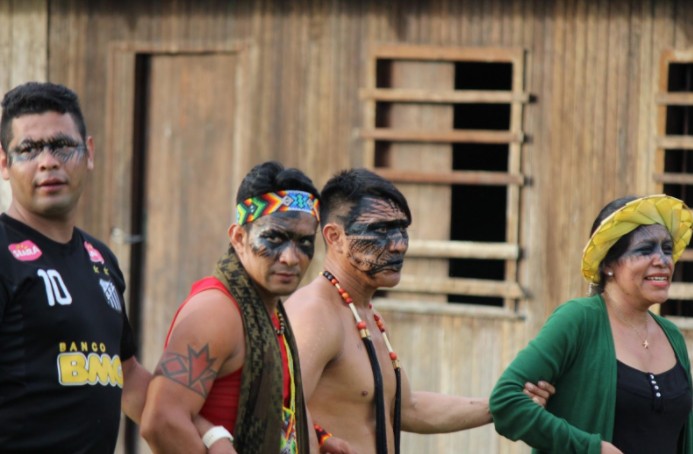Speeches Shim

As nations and communities across the globe embark on the ambitious mission of reducing greenhouse gas emissions that contribute to climate change, Indigenous Peoples and traditional forest-dwelling communities represent important allies and guides. Forest-dependent communities have long served as effective guardians of forests, and have modeled key practices around sustainable land use and natural resource management, including the protection of a greater variety of forest types within their territories as compared with other protected areas[1]. Nonetheless, the knowledge and benefits contributed by these communities have often gone unnoticed or undervalued.
Active from 2013-2018, USAID’s Accelerating Inclusion and Mitigating Emissions (AIME) project worked in Latin America to highlight and value the contributions of forest-dwelling communities by increasing their participation in and direct benefits from climate change mitigation efforts, including under the framework of Reducing Emissions from Deforestation and Forest Degradation (REDD+). AIME’s approach was applied in three directions, through capacity building of forest-dependent communities and territorial governance, the inclusion of forest-dependent communities in the development of sub-national government policies, and the enabling of private-sector engagement.
AIME operated across the region through the Forest-Based Livelihoods Consortium (FBLC), a partnership of nine organizations led by Forest Trends, which cultivated a rich exchange of ideas and practices among forest-dwelling communities. One of the unique aspects of this activity was that it partnered directly with Indigenous Peoples’ organizations as members of the implementing consortium, in addition to environmental non-governmental organizations and other more typical USAID partners.
A fruit of this exchange was the development of the Indigenous Economy Initiative. Indigenous Economy refers to locally defined economic models of Indigenous Peoples' communities, such as the Andean Quechua community’s worldview of Buen Vivir or Good Living, which emphasizes development that is based on and respects a community’s life plans, territorial integrity, and expanded sense of community[2].
“Our forms of ‘development,’ our Good Living, have worked for ages...It is not by chance that today forests exist where we inhabit.”
The Indigenous Economy Initiative originally started as a smaller discussion group; however, the topic garnered so much interest among partners that it morphed into a separate series of annual workshops and activities across the Amazon Basin region. Activities built on the original dialogue on Indigenous Peoples' economies have ventured into how locally defined economies of forest-based communities can join the market economy in ways that ensure equity, sustainability, and territorial self-determination.

The annual Indigenous Economy workshops supported by AIME brought together consortium members, Indigenous Peoples' leaders, and Indigenous Peoples' economy specialists from all over Latin America. The workshops provided participants dedicated time and space in which to discuss questions, challenges, and opportunities around advancing an Indigenous Peoples' economy. Participants since articulated these reflections in four booklets describing their visions of Indigenous Economy, territorial governance, and Indigenous enterprises.
An AIME-supported activity that further explored the relationship between Indigenous Peoples' economies and market economies was the 2016 “Economy and Forest Contest” (in Spanish), a contest that drew a wide range of entries from across Latin America describing innovative economic experiences. The winning entry, from ACE-Amarakaeri of the Madre de Dios amazon region of Peru, explored the use of sustainable Brazil Nut harvesting to generate new sources of income while also counteracting illegal logging, mining, and resource extraction activities in the area and promoting greater socioeconomic value of forestlands. This enterprise also aligns closely with ACE-Amarakaeri’s successful territorial governance which is based on an alliance of 10 Hakbut, Yine, and Machiguenga ethnic communities. The alliance recently procured the recognition of their 400,000+ hectare territory as a communal reserve, and plan to extend their territory in order to incorporate several communities involved in the enterprise. The Economy and Forest Contest helped to highlight linkages between territorial governance and Indigenous Economy, and share success stories from groups like ACE-Amarakaeri.
In addition to this contest and the booklets published, the Indigenous Economy Initiative spurred various other learning and exchange opportunities. Webinars and trainings on certifications, value chains, and international fairs were conducted. Two exchanges between Central American country participants took place in order to share and identify community-based enterprise opportunities. And ultimately one of the best outcomes for the AIME program was the sharing and creation of knowledge driven and determined by forest-dependent communities themselves.
[1] Asner’s “Conservation assessment of the Peruvian Andes and Amazon based on mapped forest functional diversity” (2017) showed more even distribution of protection for the 36 Forest Functional Classes (FFC), contributing to the overall diversity of forests classes present and protected in Peru;https://www.sciencedirect.com/science/article/pii/S0006320717301702
[2] The Buen Vivir worldview is described throughout the Indigenous Economy booklets published by Forest Trends, with more detail about the model in the Territorial Governance and Indigenous Economy and Two Spheres of Indigenous Economy booklets.

Comment
Make a general inquiry or suggest an improvement.